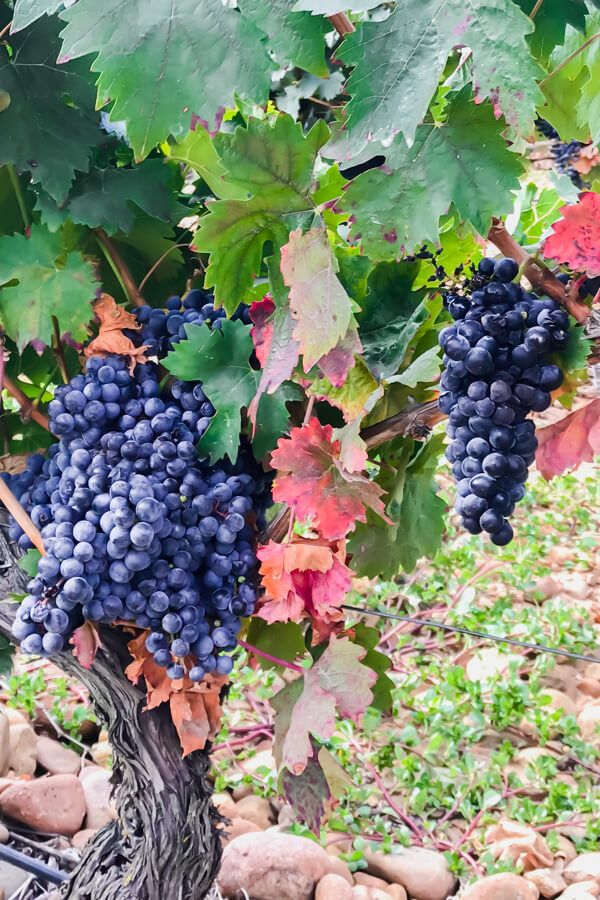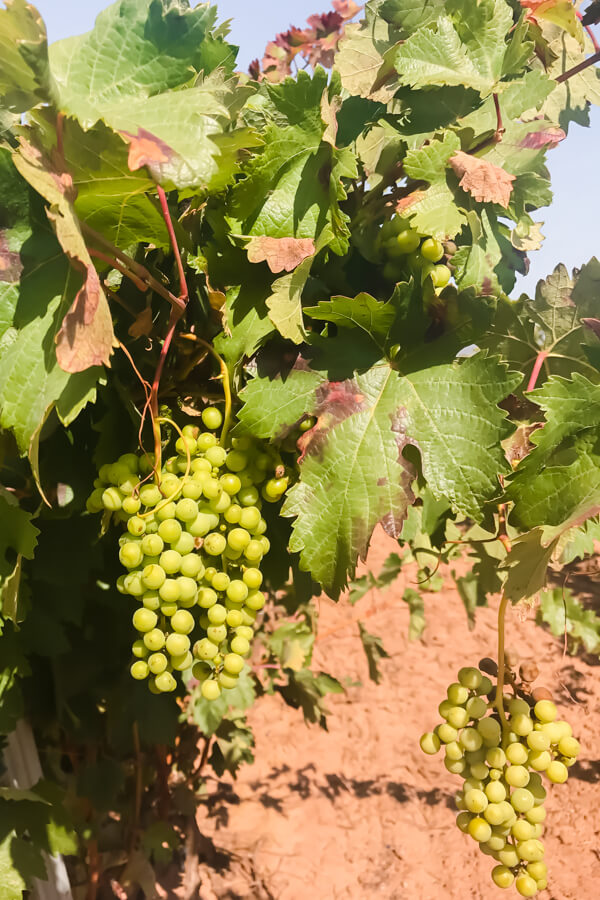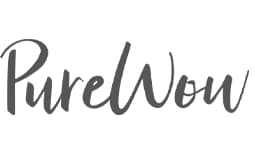Drinking wine in moderation has been recommended in many dietary philosophies including the Mediterranean diet, but not all wine is created equal. Read on to learn about my investigation into the natural organic wine world and why I will never again drink conventional wine.
This post is a slight departure from what I typically share, but a topic that I have become quite interested in lately and field questions about frequently from private clients; Can I still drink wine on a healthy diet?
Must start here: Alcohol is a touchy topic. I have strong opinions about alcohol consumption in general. As a quick disclaimer if you are struggling with alcohol addiction please skip this post. Here are some of my favorite resources on addiction; I love Home podcast, the website Hip Sobriety, I also love and strongly recommend this book, and of course, AA is a fantastic resource (but in my unpopular opinion, it is not your only choice).
How you drink is more important than what you drink, so please give yourself the greatest gift ever and take a look at that. Then come back here and learn all you ever wanted to know (and way more than you ever thought you wanted to know) about wine.
How it all began
A few months ago I was walking through the Rioja region of Spain while on the Camino de Santiago pilgrimage. My sisters and I stopped around noon to make ourselves some sandwiches, eat about a bushel of olives, and take a break. We were probably somewhere around kilometer 9 or 10 and halfway to our destination for the day. We were in the vineyards of Rioja, literally, surrounded on all sides by grapes. Glorious, beautiful, magical, all of it. We walked a bit deeper into the vines and found the perfect spot to rest and eat our lunch. As we were getting started on our olive appetizer, a car pulled up, it was the vineyard owner. Little sis, Becky, ran over to the car (she's our Spanish speaker) and graciously asked if it would be ok if we had our lunch there, “Here, in your beautiful vines? We promise to not touch any of the grapes”, she said. The elderly couple clapped in excitement and said, “Of course, you are welcome to enjoy our land, but you must, must! must! must! try our grapes!” Please, they said, take a handful, eat them, share them with your sisters. Becky giggled, are you sure?, Yes, yes! Eat some now in front of us, they said, we want to see your face when you taste them.
This.
This is why I love wine.
This moment in Rioja, the pride of the grape growers, the love and generosity, and pure life that resides in a grape. The care, toil, and sweat that is required to create a truly beautiful wine. The people, the families, the joy. Wine, for me, is not about the buzz or the alcohol, it's about that family in Rioja, and those grapes I shared with my sisters on a warm Spanish afternoon.
Now, sadly, I am about to burst that beautiful idyllic wine bubble. A large majority of wines grown today are not grown the traditional way, in fact, they are grown in ways that are deeply detrimental to our health – beyond just the toxicity of the alcohol.
I thought wine was good for me?
Most studies show that moderate wine consumption can be protective against cardiovascular disease and other chronic conditions. Moderate is defined as 1 (4 -ounce) glass of wine per day for women and 2 (4-ounce) glasses of wine per day for men. A U- shaped curve exists here, meaning, drinking a little is ok for you, drinking too much is not.
In recent research studying the blue zones around the world, the areas in the world where people live the longest, most fulfilling lives, researchers discovered something interesting. In nearly every blue zone region from the mountains of Barbagia in Southern Italy to the subtropical islands of Okinawa, Japan the regions with the longest – living people moderate wine consumption was part of the culture. (source)
 Isn't that good enough? Why dig deeper into wine research?
Isn't that good enough? Why dig deeper into wine research?
My personal relationship to wine started to go awry when I began to notice this strange feeling of anxiety and restlessness that would fill my body from head to toe on the nights that I drank wine. Racing heartbeat, restless legs, sometimes a dull headache or joint aches, it was just super uncomfortable. Next, I noticed my sleep was irregular and becoming challenging. I was struggling to fall asleep, and when I did fall asleep I would wake up in a few hours with that anxiety all over again. Even if I only drank a very small glass of wine (3 ounces).
Knowing what I know about the effects of food on the body I did what I do best – I investigated.
First step: I stopped drinking. Wouldn't you know all of those strange symptoms went away? Sleep improved, anxiety improved, aches stopped.
Dammit, I thought, please not my wine!
Then I spent a few weeks in Europe and drank wine every day, most days 2 or more glasses. No anxiety. No issues with sleep. No aches (aside from the natural kind of aches that arise from walking 20 miles per day). Even on days, I wasn't hiking I would drink wine and feel fine.
Hmm… was this a reaction to alcohol? If so, then why did the symptoms disappear when I was traveling?
I naturally have less anxiety on a trip, but the anxiety I was getting at home was different than stress-induced, it felt biological. It felt like something wasn't agreeing with me.
The Deeper Investigation Began –
In the midst of all this wine curiosity, I was back and forth with drinking. I would try wine again at home, weird feelings would come back. I would stop drinking, I felt better.
Stay away from wine, my body screamed. Back the H- off, my head screamed back!
And then the best Christmas present in the world arrived at my front door, from my BFF, Karen. It was a delivery from a company called, Dry Farm Wines, a case of wine. Hah! I can't stop drinking now!
I had tasted Dry Farm Wines at Karens' house a few months earlier and fell in love. Each bottle was exactly the kind of wine I loved; old world, a little stinky, dry, and complicated. Perfect.
What is Dry Farm Wine?
Dry Farm Wine is a wine club that curates dry-farmed (read below to see what that means), low-alcohol, low-sulfite, additive free, sugar-free wine.
Dry farm wines are:
- Low in alcohol <12.5%
- Are Sugar and Carb Free <1g/L
- Low in Sulfites <75ppm
- Are Mycotoxin Mold Free (Lab-Tested)
- Doesn't disrupt sleep
- Are Bio-Certified Pure, Organic, Dry-farmed and free of all chemicals and additives
Wait a minute – could it be the KIND of wine I was drinking that was making me sick? Of course I deeply understand the impact of pesticides and herbicides in my food, but honestly, I never thought about my wine.
I even asked the owner of the really nice wine store in my neighborhood about biodynamic wines (I had tasted one at a restaurant and LOVED it), he replied, that doesn't make any difference.
Huh.
Why was wine making me sick?
As I started digging deeper into this mystery I was shocked to discover that the Food and Drug Administration (FDA) approved 76 chemical additives for use in winemaking. 76 chemicals! No!!!
Before I get too far down a rabbit hole here, let's be clear that the United States is not alone in approving chemicals for winemaking. Overall, I've discovered that unless you are buying organic, biodynamic wine there is no guarantee that there might be some odd chemicals lurking in your pinot noir.
You see, what is happening in modern wine production is not much different from what is happening in all of agribusiness or big food. The goal is to make wine cheaper and faster, not better and healthier. The goal is also to produce a consistent product. Commerical wine producers are making millions of bottles and they want them all to look and taste the same. Which is completely irrational as wine is a natural product and for thousands of years we, as consumers, have accepted that each growing season will produce a very different product. I dare you to buy 10 bottles from a big conglomerate wine producer and see if you can detect any seasonal variance – you can't – you won't – there isn't' any. They are using chemicals and additives to produce a consistent product, bottle after bottle.
Here is a selective list of some of the concerning agents in conventional wine production:
- Sulfur dioxide– Commonly known as “sulfites” this is what most people assume is the culprit causing that “red wine headache”. Sulfites are a preservative widely used in winemaking as it plays an important role in preventing oxidization and maintaining wine's freshness. Essentially, sulfites are used to kill unwanted bacteria. A very small population of people (about 1% of the population) have sulfite sensitivity and thus have a reaction to the low levels of sulfites in wine. Wine typically has about 150ppm of sulfur added, conventional wines in the United States can have up to 350ppm, dried fruit has around 1,000 ppm. So if you aren't getting a headache from your dried apricots, your wine headache is likely not to be blamed on sulfites. Also, white wine typically contains more sulfites than red, an important point since most people I know think they are sensitive to red wine but not white wine.
- Sugar – Yeast ferments the natural sugars found in grapes. When you taste a very “dry” wine that typically means that the yeasts have fully fermented all of the sugar into alcohol. It is a standard practice for some winemakers to add additional sugar before the fermentation process to alter the flavor and alcohol content of the wine. You don't necessarily taste these added sugars, but they could be the reason that some wines make you feel worse than others. A process called “chaptalization” is used by many wine growers to appeal to the sweeter American palate, this process adds sugar or high fructose corn syrup to the wine.
- Commerical Yeasts – As mentioned above, yeast is necessary to ferment the sugars in the grapes into wine. Traditionally all wines were fermented with naturally occurring yeast. To gain more control over the natural fermentation process many winemakers now opt for commercial yeasts, which are often genetically modified and can induce headaches in sensitive individuals.
- Mega Purple – Mega purple is a super concentrated grape juice artificial coloring agent that is used to produce a consistent color in wine. Naturally, red wine isn't supposed to stain your lips, clothing, or teeth, but mega purple certainly will. Mega purple is added to 25 million bottles of wine per year, virtually every red wine under $20 will contain this artificial coloring agent.
- Mycotoxins – These are toxic substances produced by fungi and found in grains, wine, apple juice, and other natural products. Mycotoxins have been linked to diabetes, obesity, and kidney disease. The European Union has strict regulations on mycotoxin levels in wine. Organic and sustainably produced wines have been found to contain a much lower amount of mycotoxins.
- Pesticides, Herbicides, and Fungicides – Wine is a naturally grown product, thus it has the same challenges as broccoli when it comes to the use of chemicals to improve growth potential. Glyphosate, the active chemical in Monsanto's RoundUp is the #1 herbicide used in U.S. vineyards. Choosing organic wine over conventionally produced will help you avoid these toxic endocrine disrupting chemicals.
Wowzer – these chemicals and additives could be causing the problem for sure! In short modern wine production creates a product that is higher in alcohol, higher in sugar, and laden with harmful chemicals and additives in an attempt to “standardize the wine” (same taste and mouthfeel bottle after bottle), improve the color, texture, and flavor.
There are currently zero labeling laws in winemaking. Wine is the only major food group without a contents label. So you have no way of knowing how many of these 76 chemicals have ended up in your Chardonnay.
Winemakers have found techniques to mask their low-quality, poor-tasting grapes. Winemakers are also veering away from traditional dry-farming practices and using irrigation systems to further manipulate the sugar and alcohol content of wine.
The difference between dry farming and irrigation
In most old world wine regions rainfall is the only source of water for the vineyard and the way in which a vineyard maintains it's characteristics of terroir, the complete natural environment in which wine is produced. Dry farming (or farming without irrigation) is considered the gold standard. When a vine is “dry farmed” the roots tend to sink deeper into the soil in search of minerals and moisture. This deeper root of the vine provides more nutrients and character to the grape, and thus the wine, producing a more complex wine that reflects the soil in which it grew. France, Italy, Germany, and Spain have been dry farming for centuries. By in large the European wine industry forbids the practice of irrigation.
Irrigation, on the other hand, is viewed by many critics as manipulative and detrimental to wine quality. Meddling with wine's terroir by artificially watering the vine is seen as unnatural and by in large is forbidden within the European wine industry.
American farmers discovered that irrigating vines produced more wine, and do you know what Americans like? more, more, more… of everything. More wine means more money, so it became a no-brainer. Irrigate the crops. Today the majority of California wineries irrigate their vineyards, even in areas that get plenty of rainfall.
How does dry farming and irrigation affect the taste?
This is where it gets interesting. When you water a vine or give a vine a bunch of water the result is that the grape tends to have more sugar. It produces a sweeter, bolder, heavier, fruit forward wine. It also increases the alcohol content, more sugar = more alcohol. Irrigation is the reason that alcohol levels in wine have climbed steadily over the past 30 years.
To be clear, there are some instances where levels of irrigation are necessary, like in a drought, for instance. The general consensus is that an irrigated vineyard will produce a very different wine than a traditional dry farmed vineyard.
Back to me crying in my wine glass because drinking was making me sick…
What Happened When I Drank Dry Farm Wine?
Nothing.
Ha.
No headache, no sleep disturbance, no weird anxiety. Nothing. I enjoyed each and every wine, shared most bottles with my family, and overall was pretty dang happy.
Dry Farm Wines are all naturally lower in alcohol, which I love and:
Sourced from small, organic vintners. This means no added pesticides, herbicides, fungicides, or other harmful chemicals.
Cultivated through “dry-farming”.
Naturally low in sulfites.
Sugar-free. Some modern wines have more sugar than a liter of cola! Fortunately, all Dry Farm Wines have less than 1 g/L. So you get all the antioxidants and nutrients without the sugar.
Made without artificial additives.
Dry Farm Wines is generously offering an additional bottle of wine for one penny with any purchase. I highly recommend trying their wine and seeing how you feel. Click here to claim your one penny bottle of wine.
How to know if your wine is natural, organic, and /or biodynamic?
- Look for third-party certifications – labels like organic or biodynamic is a start. My wine store just started putting a green sticker on all wines that are biodynamic. Ask your wine seller for suggestions.
- Look at the importer – when you find a great organic/ biodynamic wine that you love, look at the back of the bottle to see who the importer is. Typically great importers have a theme across their wine selection. This is a trick that was taught to me by Jordan years ago (there are some perks to working in the restaurant industry for over a decade). When we found a wine we loved we would check the importer and try more wines from their line.
- Pay attention to taste – if you find that your bottle of yellowtail (sorry to call out a specific label but — I've got to do it!) always tastes the exact same then most likely the winemakers are using farming and production practices that can cause health concerns. If it quacks like a duck…
- Pay attention to price – sort of. In the U.S. most organic/biodynamic wines are more expensive. In Europe, I was buying bottles of small- farm, biodynamic wines for a few dollars. If the bottle is under $10 in the U.S. most likely that wine has been doctored in some way. It's better to fly to Europe and drink cheap wine than to drink cheap wine in the states.
I would love to hear your thoughts on this topic! Enter your email in the first box below to receive a free natural wine guide that summarizes this info (so when your Aunt Sue asks why your wine has changed you can just show her the natural wine guide).
Definitely, try Dry Farm Wines and claim your bottle for one penny! Click here to do that.
Cheers!!
Abra
Download your Natural Wine Guide
A quick guide to natural - organic - biodynamic wines






 Isn't that good enough? Why dig deeper into wine research?
Isn't that good enough? Why dig deeper into wine research?




















